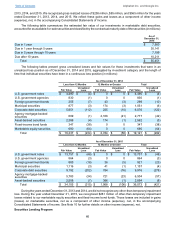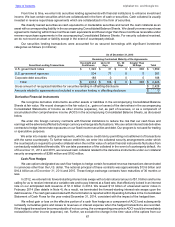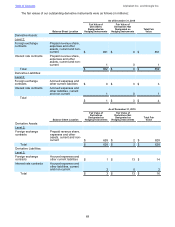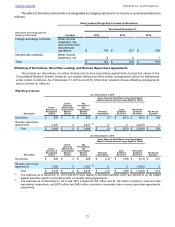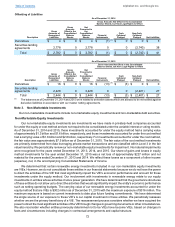Google 2015 Annual Report Download - page 68
Download and view the complete annual report
Please find page 68 of the 2015 Google annual report below. You can navigate through the pages in the report by either clicking on the pages listed below, or by using the keyword search tool below to find specific information within the annual report.
Table of Contents Alphabet Inc. and Google Inc.
64
of 2016 on a retrospective basis. We do not expect the adoption of this standard to have a material impact on our
consolidated financial statements.
In February 2015, the FASB issued Accounting Standards Update No. 2015-02 (ASU 2015-02) "Consolidation
(Topic 810): Amendments to the Consolidation Analysis." ASU 2015-02 changes the analysis that a reporting entity
must perform to determine whether it should consolidate certain types of legal entities. We will adopt this standard in
the first quarter of 2016 on a retrospective basis. We do not expect the adoption of this standard to have a material
impact on our consolidated statement of operations or consolidated balance sheet, but it may result in additional
disclosures.
In November 2015, the FASB issued Accounting Standards Update No. 2015-17 (ASU 2015-17) “Income Taxes
(Topic 740): Balance Sheet Classification of Deferred Taxes”. ASU 2015-17 simplifies the presentation of deferred
income taxes by eliminating the separate classification of deferred income tax liabilities and assets into current and
noncurrent amounts in the consolidated balance sheet statement of financial position. The amendments in the update
require that all deferred tax liabilities and assets be classified as noncurrent in the consolidated balance sheet. The
amendments in this update are effective for annual periods beginning after December 15, 2016, and interim periods
therein and may be applied either prospectively or retrospectively to all periods presented. Early adoption is
permitted. We have early adopted this standard in the fourth quarter of 2015 on a retrospective basis. Prior periods
have been retrospectively adjusted.
As a result of the adoption of ASU 2015-17, the Company made the following adjustments to the 2014 balance
sheet: a $1,322 million decrease to current deferred tax assets, a $83 million increase to noncurrent deferred tax asset,
a $26 million decrease to current deferred tax liability, and a decrease of $1,213 million to noncurrent deferred tax
liability.
In January 2016, the FASB issued Accounting Standards Update No. 2016-01 (ASU 2016-01) "Financial
Instruments-Overall (Subtopic 825-10): Recognition and Measurement of Financial Assets and Financial Liabilities."
ASU 2016-01 amends various aspects of the recognition, measurement, presentation, and disclosure for financial
instruments. With respect to our consolidated financial statements, the most significant impact relates to the accounting
for equity investments. It will impact the disclosure and presentation of financial assets and liabilities. ASU 2016-01 is
effective for annual reporting periods, and interim periods within those years beginning after December 15, 2017. Early
adoption by public entities is permitted only for certain provisions. We are currently in the process of evaluating the
impact of the adoption of this standard on our consolidated financial statements.
Revision of Previously Issued Financial Statements
In the second quarter of 2015, we identified an incorrect classification of certain revenues between legal entities,
and as a consequence, we revised our income tax expense for periods beginning in 2008 through the first quarter of
2015 in the cumulative amount of $711 million. We evaluated the materiality of the income tax expense impact
quantitatively and qualitatively and concluded it was not material to any of the prior periods impacted and that correction
of income tax expense as an out of period adjustment in the quarter ended June 30, 2015 would not be material to
our consolidated financial statements for the year ending December 31, 2015. Consolidated revenues are not impacted.
We elected to revise previously issued consolidated financial statements for the periods impacted. Refer to Note 17
for additional information.
Prior Period Reclassifications
Certain amounts in prior periods have been reclassified to conform with current period presentation.
Note 2. Financial Instruments
We classify our cash equivalents and marketable securities within Level 1 or Level 2 in the fair value hierarchy
because we use quoted market prices or alternative pricing sources and models utilizing market observable inputs to
determine their fair value. We classify our foreign currency and interest rate derivative contracts primarily within Level
2 in the fair value hierarchy as the valuation inputs are based on quoted prices and market observable data of similar
instruments.
Cash, Cash Equivalents, and Marketable Securities
The following tables summarize our cash, cash equivalents and marketable securities by significant investment
categories as of December 31, 2014 and 2015 (in millions):














